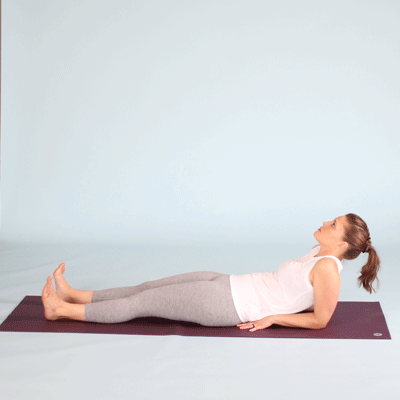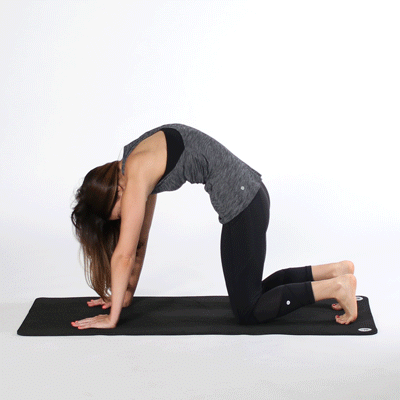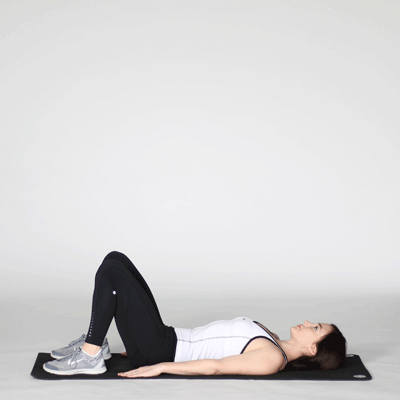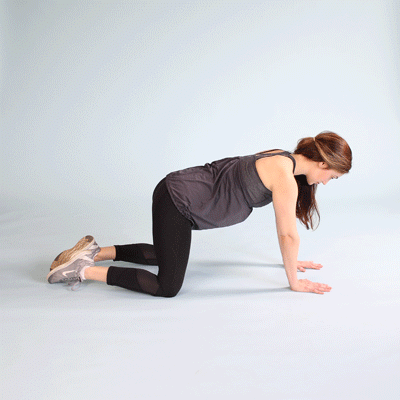The Best Positions to Help Period Cramps at Work, in Bed, or on the…
 Share on Pinterest Flamingo Images/Stocksy
Share on Pinterest Flamingo Images/StocksyPeriods can be a lot of things. For many, painful cramps are simply the norm.
This can impact your work life, social life, energy, mood, and even the quality of your sleep. If you’re someone who experiences pain, bloating, and a general feeling of blah during your period, you’re definitely not alone.
The good news is there are several steps you can take to relieve your symptoms so you can be virtually pain-free during your time of the month.
Best positions to help period cramps
There are several positions for period cramps that promote relaxation, circulation, and alignment.
When sitting in a chair
Doctor of physical therapy Laurence Agénor specializes in orthopedics, pelvic health, and dance medicine. She recommends using a lumbar support pillow on your chair to decrease low-back pressure.
Keeping your spine as neutral as possible is key, according to Agénor. Ideally, your feet are firmly planted on the ground and your hips are aligned with your knees at 90 degrees while you’re sitting.
Movement breaks
Agénor also notes the importance of taking breaks to move throughout your day.
“Getting up to walk around or move for a few minutes on an hourly basis will help minimize stiffness and improve blood flow throughout the body,” she says.
Yoga positions to help period cramps
Heading to your yoga mat may not seem intuitive when your cramps are bothersome, but yoga can provide multiple benefits.
According to a 2017 review of fifteen studies, yoga can relieve premenstrual syndrome (PMS) symptoms, such as:
A 2011 study found that yoga can reduce the severity and duration of primary dysmenorrhea (more on this below).
In addition to physical benefits, research from 2011 shows yoga can relieve mental health symptoms. For example, it may help:
Agénor says gentle movement during your menstrual cycle improves the uterine and overall blood flow throughout the body, which relieves cramping.
“Getting your body moving aids in decreasing muscular tension throughout the body, which can help ease your discomfort during that time of the month,” she says.
Whether you’re a yogi or not, the below poses can be a wonderful way to soothe painful cramps.
Supported Savasana (supine position)
Benefits:
To do this pose, lie on your back with a bolster underneath your legs. Agénor says this is the most pain-relieving position for period cramps. This helps decrease feelings of compression in the low back. In yoga, this is known as Supported Savasana.
Agénor adds that having your legs slightly above your heart improves overall circulation.
Cobra
 Share on Pinterest
Share on Pinterest Benefits:
To do this post, start flat on your stomach with your legs extended straight behind you. Then, place your hands underneath your shoulders and push up as you lift your head and shoulders off the mat.
Fish
 Share on Pinterest
Share on Pinterest Benefits:
To do this pose, lie on your back with your legs straight. Press your forearms and elbows into the floor and begin to lift your chest off the floor. Tilt your head back, so the crown of your head is on the floor.
To modify this pose, you can place a pillow or block under your head and shoulders and let your arms fall to the side.
Cat-Cow
 Share on Pinterest
Share on Pinterest Benefits:
To do this pose, get on your hands and knees. Agénor recommends a variation of this popular pose where you inhale as you arch your back and extend the spine (cat), then exhale as you draw the lower abdominals in towards the spine (cow).
Bridge
 Share on Pinterest
Share on Pinterest Benefits:
To do this pose, lie on your back with your knees bent and feet on the ground. Lift your hips toward the sky.
Agénor recommends rolling up vertebrae by vertebrae into a shoulder bridge. As you roll down, let each segment of the spine make contact one at a time with the floor.
Child’s Pose
 Share on Pinterest
Share on Pinterest Benefits:
To do this pose, get on all fours and bring your big toes together as you widen your knees. Lean your upper body over your lower body as you stretch forward with your arms and take big, deep breaths.
Roll downs (Pilates)
Benefits:
To do this pose, Agénor recommends starting with a deep inhale through the nose and exhaling out through the mouth. Tuck your chin to your chest, and roll down your spine, vertebrae by vertebrae.
“As you roll back up, you find a soft bend in the knees and feel each vertebrae stack one on top of the other, until your head is the last to come up,” she says.
Keep in mind that it’s important to listen to your body without pushing yourself. If a posture feels uncomfortable, Agénor recommends a smaller range of motion to help you feel more stable. You’ll still get the benefits.
Sleeping positions to help period cramps
Sleep is an essential recovery tool. However, it’s common to experience sleep disturbances during your period.
That’s because your hormone levels drop, causing your body temperature to rise. This can throw off your circadian rhythm.
On top of that, cramps may provide an extra layer of discomfort.
Finding a comfortable sleeping position can set you up for a good night’s rest. While Agénor says the ideal sleep position is personal, she advises maintaining neutral alignment of the spine.
Here’s what Agénor recommends for your go-to sleep position:
According to Alyssa Dweck, MD, FACOG, a top doctor in New York Magazine and Westchester Magazine, the fetal position may also provide comfort. She suspects this is due to muscle relaxation in the abdomen and the emotional comfort it may bring.
Why cramps happen
During your period, the uterus contracts to shed its lining. Hence: throbbing and achiness in your low belly.
“Cramps are primarily due to the release of prostaglandins by the uterus, resulting in muscle contractions,” Dweck says.
Prostaglandins are hormone-like chemicals made in the lining of the uterus that cause it to contract. The contractions help expel the uterus lining but can also trigger pain.
According to Dweck, this is due to blood vessels being compressed, causing a brief stop in blood flow.
That cramping pain right before or during your period has a name: primary dysmenorrhea. It’s one of the most common gynecologic disorders without another condition involved.
According to a 2016 study, primary dysmenorrhea may be associated with:
An older 2006 review showed that women with primary dysmenorrhea produce excess amounts of prostaglandins. Prostaglandin release is at its highest on the first day of your period or 1 to 3 days before your period.
When prostaglandins enter the bloodstream, they can increase the sensitivity of pain receptors. In addition to cramps, they may also cause:
Secondary dysmenorrhea may be another cause of period pain. Dweck says this is caused by an identifiable issue, like fibroids or endometriosis.
It’s always a good idea to talk with your doctor about your symptoms for a better understanding of their causes and how to manage them.
Another possible culprit of period discomfort, according to Dweck, is gastrointestinal motility changes that often go along with menstruation or PMS.
The hormone progesterone is secreted by the ovaries prior to menstruation. An older study from 1990 linked progesterone to irritable bowel syndrome (IBS) symptoms that can cause cramping or pelvic pain.
What makes cramps better?
While there’s no one-size-fits-all method for relieving period cramps, there are several things you can do to prevent or ease your pain. Dweck recommends the following:
Adopting healthy lifestyle habits can also keep your pain at bay.
A 2016 study compared the lifestyles of young women with and without primary dysmenorrhea looking at:
The researchers concluded that healthy lifestyle choices could minimize symptoms. These included:
The study also showed that eating foods, like fish, eggs, vegetables, and fruits, and reducing foods high in arachidonic acid (a type of omega 6 fatty acid), like meat and dairy, helped reduce dysmenorrhea severity. This was combined with brisk walking for 30 minutes a day for the first 3 days of menstruation.
Cycle syncing, or basing your self-care and lifestyle behaviors on where you’re at in your cycle, can also be an effective method for balancing your hormones to ease pain.
This may be especially true if you have polycystic ovarian syndrome (PCOS) or don’t feel like yourself during your period.
With diet, exercise, and lifestyle adjustments throughout each phase of your cycle, you can better support your body’s needs.
Massage for cramps
In addition to yoga, massage can also provide cramp relief.
An older 2005 study concluded that abdominal meridian massage was an effective way to relieve dysmenorrhea. Another 2010 study found massage therapy reduced pain caused by endometriosis.
Try it
You can take things into your own hands — literally — by employing a simple massage technique that targets the tenderness in the region above the pubic bone, known as the suprapubic region.Agénor instructs her clients to perform self-myofascial release in this area.To do this, take the pad of your fingers and apply gentle pressure for about 60 to 90 seconds to different areas of the front of the pelvis. “If the pain dissipates with the pressure, you know you’re doing it right,” Agénor says.
Other cramp relief options
In addition to proper positioning and massage, there are other things you can try to get cramp relief, including using special tools, eating certain foods and drinks, and trying natural remedies.
Tools and equipment
Period pain can range from mild to excruciating, so staying prepared can help you combat your symptoms early on.
Here are a few things to keep handy for cramp relief:
While research suggests there are health benefits, the Food and Drug Administration (FDA) doesn’t monitor or regulate the purity or quality of essential oils. It’s important to talk with a healthcare professional before you begin using essential oils and be sure to research the quality of a brand’s products. Always do a patch test before trying a new essential oil and dilute any essential oil with a carrier oil so it doesn’t burn your skin.
Food and drink to relieve menstrual cramps
Maintaining a healthy diet can lessen the severity of menstrual pain. Generally, eating foods that are high in fiber and plants and removing high-processed foods is a good rule of thumb to follow.
In fact, following this diet can reduce estrogen levels, which can cause painful periods.
Some foods to eat on your period include:
Drinking plenty of water is important, too. Not only does it reduce your chances of getting dehydration headaches, but it can also stop you from retaining water and bloating.
Meanwhile, some foods can exacerbate symptoms and increase prostaglandins in your body, which worsens pain. Some things to avoid if you can are:
Natural remedies for period cramps
There are a number of home remedies that may help with period cramps.
Herbal medicine can help alleviate cramps with natural anti-inflammatory compounds. Some soothing remedies include:
Ginger is commonly used for healing. It also blocks prostaglandins from forming, according to research.
Additionally, research from 2015 found that curcumin, a natural compound in turmeric, can significantly reduce PMS symptoms.
Pain relievers when nothing else works
If you feel like you’ve tried every solution, and you’re still experiencing pain, there are a few different pain relievers you can try.
It’s also OK to take over-the-counter medications, such as ibuprofen and NSAIDs. These anti-inflammatory medications, when taken at the correct dosage, can significantly reduce pain and menstrual flow.
However, it’s always a good idea to speak with your doctor if you’re consistently relying on NSAIDs to ease cramps.
Frequently asked questions
Want to learn more? Get the FAQs below.
Why are my cramps worse on the first day of my period?
Prostaglandin levels are highest during this time. These hormone-like chemicals cause the muscles and blood vessels of the uterus to contract, which leads to pain.
As the uterine lining sheds throughout your period, prostaglandin levels go down and the pain lessens.
Why are my cramps worse at night?
While this is not the case for everyone, some people experience worse cramps at night. This may be because there are fewer distractions from the day.
Sleep is imperative for day-to-day functioning, and it’s important to find a comfortable sleeping position that supports your spine and lower back.
Can I go upside down or do an inversion on my period?
It depends, according to Agénor.
Inversions can actually help improve blood flow throughout the body and to the uterus. However, if someone is already experiencing pain or instability in the low back and pelvis, inversions are not recommended.
“A [gentler] exercise is legs up against the wall with a pillow underneath the low back,” Agénor says. “If that’s still too much, lying on your back with a bolster propped up underneath your legs can be an even gentler alternative.”
Traditional yogic wisdom recommends against inversions during your period, because it reverses the body’s downward flow of expelling uterine tissue from the body.
Still, scientific research doesn’t indicate that inversions during your period are harmful.
What if I have endometriosis or PCOS?
Period pain can be extremely severe if you have endometriosis or PCOS, but there are some solutions. Here are a few recommendations from Dweck that you may explore with your healthcare professional:
Agénor recommends doing meditations that involve diaphragmatic or deep belly breathing. This can be done in any position that’s comfortable to you, with the goal of calming the central nervous system and decreasing pain sensitivity.
What’s the fastest way to get rid of cramps?
It’s important to experiment and find a method that works for you, as cramp relief can be specific to each individual.
For many, physical exercise, heat, and oral pain relievers are the quickest way to relieve cramps.
Takeaway
Generally speaking, supporting your body with a healthy diet and exercise can lessen cramp pain when it’s your time of the month.
It’s also recommended to track your period, so you can use your favorite tools and remedies before your pain hits.
With a little forethought and a few tools on hand, you can go about your days with ease — even when you’re menstruating.
Julianne Ishler is a freelance writer, creative mentor, and certified Enneagram practitioner. Her work revolves around helping people live more mindfully and aligned with themselves. You can follow her on Instagram for self-discovery resources or visit her website.
Posted : 2024-08-29 10:50
Read more

Disclaimer
Every effort has been made to ensure that the information provided by Drugslib.com is accurate, up-to-date, and complete, but no guarantee is made to that effect. Drug information contained herein may be time sensitive. Drugslib.com information has been compiled for use by healthcare practitioners and consumers in the United States and therefore Drugslib.com does not warrant that uses outside of the United States are appropriate, unless specifically indicated otherwise. Drugslib.com's drug information does not endorse drugs, diagnose patients or recommend therapy. Drugslib.com's drug information is an informational resource designed to assist licensed healthcare practitioners in caring for their patients and/or to serve consumers viewing this service as a supplement to, and not a substitute for, the expertise, skill, knowledge and judgment of healthcare practitioners.
The absence of a warning for a given drug or drug combination in no way should be construed to indicate that the drug or drug combination is safe, effective or appropriate for any given patient. Drugslib.com does not assume any responsibility for any aspect of healthcare administered with the aid of information Drugslib.com provides. The information contained herein is not intended to cover all possible uses, directions, precautions, warnings, drug interactions, allergic reactions, or adverse effects. If you have questions about the drugs you are taking, check with your doctor, nurse or pharmacist.
Popular Keywords
- metformin obat apa
- alahan panjang
- glimepiride obat apa
- takikardia adalah
- erau ernie
- pradiabetes
- besar88
- atrofi adalah
- kutu anjing
- trakeostomi
- mayzent pi
- enbrel auto injector not working
- enbrel interactions
- lenvima life expectancy
- leqvio pi
- what is lenvima
- lenvima pi
- empagliflozin-linagliptin
- encourage foundation for enbrel
- qulipta drug interactions
